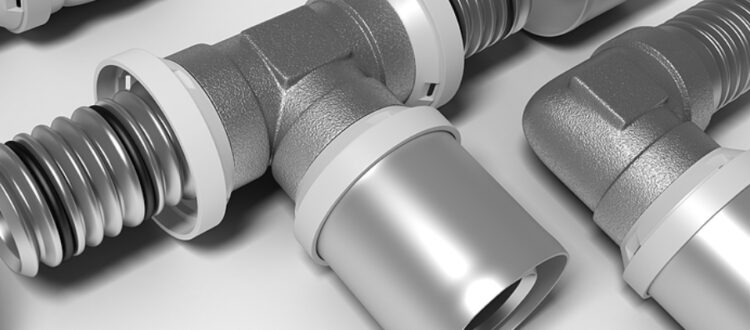A Guide On Sizing Straight And Mechanical Pipe Tee Fittings
When talking about the various terms in pipe fittings, tees are almost always the first things that come to mind. As one of the most frequently used components in pipe fitting in Singapore, they are easily identified by their characteristic T-shape, featuring three openings, two aligned and one branching at a 90-degree angle. Their design allows for the efficient redirection, combination, or division of fluid flow within a network of pipes. Tees also play an essential role when there’s a need to connect different pipe sizes or types.
However, confusion often arises when selecting the correct tee, especially when the openings differ in size or connection type. Some tees may even incorporate a mix of threaded and grooved ends, which adds another layer of complexity. Understanding how these tees are sized and the industry-standard nomenclature used is vital for choosing the correct component for any given application.
Below, we explore the various sizing conventions for the most common tee types: straight (or equal) tees, reducing tees, and mechanical tees used in grooved piping systems.
Decoding pipe tee sizing: Nominal dimensions, not actual size
Before diving into the different tee types, it’s important to note that pipe sizes referenced in this context are nominal sizes, not actual physical measurements. This is a standard convention in the piping industry and ensures consistency across fittings and components.
Straight (equal) tees and reducing tees
Standard tees are typically divided into two categories: straight (also called ‘equal’) tees and reducing tees. The primary difference lies in the size of their openings.
1. Straight tees
These have three openings of the same nominal size. Because all ends are equal, they are usually listed with a single size. For example, a 6-inch straight tee may be specified as 6 x 6 x 6. You might sometimes see just 6 inches in documentation, particularly when the uniformity of the ports is obvious or assumed.
2. Reducing tees
Reducing tees, on the other hand, accommodate connections of different sizes and are labelled using a three-part size format: A x B x C. In this format:
- A and B represent the two in-line (horizontal) openings.
- C represents the branch outlet at a right angle to A and B.
There are several variations of reducing tees:
- When A and B are the same size and C is smaller, the format is straightforward. For instance, a 6 x 6 x 3 tee connects a 3-inch branch to a 6-inch pipeline.
- In some configurations, A is larger than B and C, where B and C might be equal. An example might be 8 x 4 x 4, with the understanding that C is always the right-angle outlet.
- All three openings can also differ in size. For example, 10 x 6 x 4. In this case, identifying the right connection still relies on knowing that C, the perpendicular outlet, is always listed last, while A and B are interchangeable due to the tee’s symmetry along the horizontal axis.
Mechanical tees for grooved pipe systems
In grooved piping systems, standard welded or threaded tees are often replaced by mechanical tees. These are specialised fittings designed to create a branch connection by clamping directly onto an existing pipe after a hole has been cut.
Unlike standard tees, mechanical tees are described using only two measurements:
1. The pipe size the tee attaches to.
2. The size of the branch outlet.
For example, a 4 x 2 mechanical tee connects a 2-inch outlet to a 4-inch pipe. Since it involves clamping rather than fully joining three pipe sections, the third dimension is unnecessary.
This simplicity is especially valuable for applications where field modifications are needed or where welding and threading are impractical. Mechanical tees are a popular choice in projects where flexibility and ease of installation are often key due to tight project timelines and varied infrastructure.
How to read tee sizes with confidence
At first glance, the combination of dimensions and connection types can make pipe tees appear complex. But once you understand the logic behind the size formatting (particularly the A x B x C notation), it becomes significantly easier to identify and select the correct fitting.
- C is always the outlet at a right angle.
- A and B are the two aligned ends and are functionally interchangeable in most installations.
- Mechanical tees simplify matters further by requiring only two dimensions for specification.
By internalising this system, selecting the correct tee, whether for flow direction, branching, or size reduction, becomes far more straightforward.
Conclusion
Pipe tees may seem deceptively simple, but their sizing and variety can introduce challenges for those unfamiliar with industry standards. Whether you’re dealing with equal tees, reducing tees, or mechanical tees for grooved systems, understanding how sizing is denoted ensures compatibility and efficiency in your piping layout. With a firm grasp of the A x B x C format and awareness of when alternative fittings like mechanical tees are appropriate, you’ll be equipped to make informed choices across a wide range of applications.
Need help choosing the right pipe fitting in Singapore? Pharmchem Engineering offers a wide range of high-quality tees and piping solutions, along with expert guidance, to ensure the perfect fit for your system. Contact us today to find the best components for your next project.

